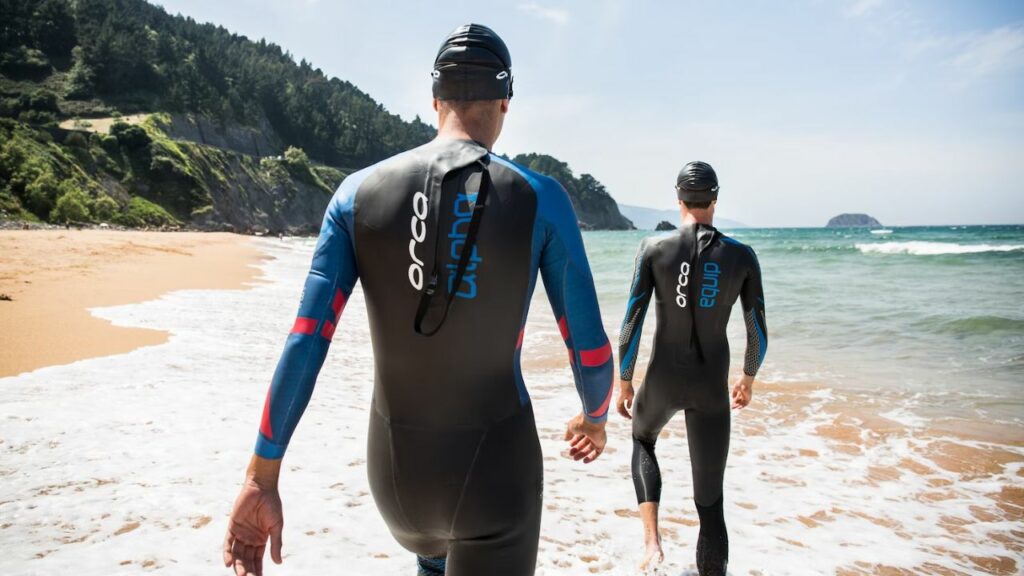If you’re into watersports, you’ve likely encountered the debate of whether surfing wetsuits are suitable for swimming. Interestingly, it’s important – so you can determine if it’s worth investing in a separate swimming wetsuit.
Wetsuits are essential for water sports enthusiasts who want to stay warm in cold water and protect their skin from sunburn and chafing. They are designed to trap a thin layer of water between your skin and the suit, then heat by your body temperature, keeping you warm even in chilly waters.
Surfing wetsuits can be good for swimming in cold water because they provide insulation to keep the body warm. But, they can be restrictive and limit movement. While you can technically wear a surfing wetsuit for swimming, there are better choices for optimal performance and comfort in the water.
Why do we use wetsuits in the first place?
Wetsuits are a common sight on beaches worldwide. They were originally designed for surfers to keep them warm in cold water.
Surfing wetsuits are made of neoprene, a great insulator material that can trap a thin layer of water between the suit and the skin. This layer of water is then heated by the body, providing warmth and insulation for the surfer.

The thickness of a wetsuit varies depending on the water temperature and the surfer’s preferences. Thicker wetsuits provide more insulation and are suitable for colder water, while thinner wetsuits are better for warmer water and allow for greater flexibility and range of motion.
In comparison, swimming wetsuits serve a completely different purpose. They are typically thinner and more form-fitting than those designed for surfing. They are made of a lighter, more flexible neoprene that allows for greater freedom of movement and less drag in the water.
The primary purpose of a wetsuit for swimming is to provide buoyancy. It’s useful for beginners still developing their swimming technique or for open-water swimmers who need to conserve energy and stay afloat for longer.
So, are they interchangeable?
Technical Differences B/W Surfing & Swimming Wetsuits
Regarding wetsuits, some key differences between surfing wetsuits and swimming wetsuits are important to consider. While both types of wetsuits keep you warm and comfortable in cold water, some key differences exist in their design and features.
| Feature | Surfing Wetsuits | Swimming Wetsuits |
| Thickness | Thicker | Thinner |
| Material | Durable Neoprene | Lightweight |
| Design | More padding and reinforcement | Streamlined design |
| Buoyancy | More buoyant | Less buoyant |
| Other | Extra flexible material in areas that require greater movement | Smoother seams and a snugger fit |
Thickness:
Surfing wetsuits are typically thicker and made from more durable neoprene material, which helps protect surfers from the impact of waves and other hazards. On the other hand, swimming wetsuits are thinner and made from more lightweight materials that allow greater water mobility and flexibility.
Design:
Another key difference between the two is their design and features. Surfing wetsuits often have extra padding and reinforcement in areas more prone to impact and wear, such as the knees, elbows, and chest. They also often have more flexible material in areas that require greater movement, such as the shoulders and arms.
On the other hand, swimming wetsuits are designed with hydrodynamics in mind. They often have a more streamlined design that reduces drag and allows for greater speed and efficiency in the water. They also often have features like smoother seams and a more snug fit, further reducing drag and increasing buoyancy.
Buoyancy:
Surfing wetsuits often provide more buoyancy, which can help surfers stay afloat and paddle more easily. On the other hand, swimming wetsuits provide less buoyancy, allowing for greater speed and agility in the water.
Pros & Cons of Using a Surfing Wetsuit for Swimming
| Pros | Cons |
| Keep you warm in cold water | Can be too thick and restrictive for comfortable swimming |
| Protect against jellyfish and other stings | Can cause overheating in warmer water or during intense exercise |
| Protect against jellyfish, and other stings | Can cause overheating in warmer water or during intense exercise |
| Provide added buoyancy and stability | Can be more expensive than regular swimwear |
| Durable and long-lasting | May not be as hydrodynamic as specialized swimwear |
| May provide additional protection against elements like wind and sun | May not be permitted in certain swimming areas or competitions |
Note: These pros and cons are generalizations and may not apply to all surfing wetsuits or individual preferences and circumstances.
Benefits
A. Warmth and comfort
Wetsuits are designed to keep you warm and comfortable in the water by trapping a thin layer of water between your skin and the suit. The trapped water is warmed by your body heat, providing an insulating layer that helps to maintain your core body temperature.
This is especially important in colder water temperatures, as prolonged exposure to cold water can lead to hypothermia. Surfing wetsuits are typically thicker than swimming wetsuits, providing more insulation and warmth. This can be especially beneficial for swimming in open or cooler water temperatures.

B. Better range of motion
Swimming wetsuits is designed to be form-fitting and streamlined, reducing drag in the water and allowing for a maximum range of motion. However, this tight fit can also be restrictive, especially for those not used to wearing a wetsuit.
Surfing wetsuits, however, are designed to allow for more movement and flexibility. This is because surfing requires a greater range of motion than swimming, as surfers must paddle, duck-dive, and pop up on their board.
The looser fit of a surfing wetsuit can be more comfortable for some swimmers, allowing for greater freedom of movement and a more natural feel in the water.
C. Protection from the sun and elements
Spending prolonged periods in the sun and water can take a toll on your skin. Sunburn, chafing, and skin irritation are common problems for swimmers and surfers.
Surfing wetsuits typically have a higher neckline, long sleeves, and legs than swimming, providing more coverage and protection from the sun and elements. Some surfing wetsuits also have built-in rash guards, which can further protect your skin from chafing and irritation.
Drawbacks
Surfing wetsuits have their advantages when it comes to keeping you warm, providing additional buoyancy, and protecting you from the sun and elements. However, they may only sometimes be the best option for swimming.
A. Limited flexibility.
One of the main issues with using a surfing wetsuit is that they are designed for surfing, not swimming. This means they may provide different flexibility than a swim-specific wetsuit.
Surfing wetsuits are typically thicker and have more neoprene panels, restricting your movements and making swimming harder. This can be especially true for movements that require a lot of arm and shoulder rotation, such as the freestyle stroke.
B. Slower drying time
Another drawback is that they take longer to dry than swim-specific wetsuits. This is because neoprene can trap water and take longer to evaporate.

If you plan on swimming multiple times a day, you may need to wear a damp wetsuit or wait for it to dry between sessions.
C. Unsuitable for competitive swimming.
While surfing wetsuits can provide warmth and buoyancy, they may not be suitable for competitive swimming. It’s because they can provide too much buoyancy, which can be an advantage in open water or surfing, but a disadvantage in a pool.
Additionally, surfing wetsuits may not be designed with hydrodynamics in mind, which can impact your ability to move through the water efficiently.
Surfing wetsuits may be a good option for keeping you warm and protected while swimming, but they won’t provide the same flexibility and hydrodynamics as a swim-specific wetsuit.
If you want to swim competitively, investing in a wetsuit designed specifically for swimming may be best.
How thick should a wetsuit be for swimming?
Generally, a swimming wetsuit should typically be around 2mm to 5mm thick. The thickness you choose will depend on several factors, such as the water temperature, the duration of your swim, and your personal preference.
Although colder water temperatures require thicker wetsuits, warmer water temperatures may only require a thinner wetsuit for protection and buoyancy. Choosing a wetsuit that fits well and provides the necessary warmth and comfort for your swimming activities is important.

